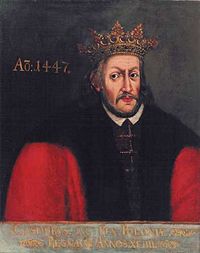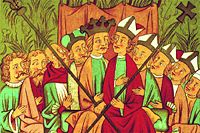Casimir IV Jagiellon
| Casimir IV Jagiellon | |
 |
|
| Kazimierz IV | |
| Reign | June 29 1440-7 June 1492 (Grand Duke of Lithuania) 25 June 1447-7 June 1492 (King of Poland) |
|---|---|
| Coronation | 29 June 1440 in Vilnius Cathedral as Grand Duke of Lithuania 25 June 1447 in Wawel Cathedral as King of Poland |
| Born | November 30, 1427 |
| Birthplace | Kraków, Poland |
| Died | 7 June 1492 (aged 64) |
| Place of death | Hrodna, modern Belarus |
| Buried | Wawel Cathedral, Kraków |
| Consort | Elisabeth of Austria |
| Offspring | Vladislaus II of Bohemia and Hungary Jadwiga Jagiellon St. Casimir Jagiellon John I of Poland Alexander of Poland Zofia Elżbieta Sigismund I the Old Fryderyk] Elżbieta II Anna Barbara of Poland Elżbieta III |
| Royal House | Jagiellon |
| Father | Jogaila |
| Mother | Sophia of Halshany |
Casimir IV Jagiellon (Polish: Kazimierz IV Jagiellończyk [ka'ʑimi̯ɛʒ jagi̯ɛl'lɔɲʧɨk]; Lithuanian: Kazimieras Jogailaitis; Belarusian: Kazimir Jahajłavič; 30 November 1427 – 7 June 1492) of the Jagiellon dynasty, was Grand Duke of Lithuania from 1440, and King of Poland from 1447, until his death.
Casimir was the second son of King Władysław II Jagiełło (Jogaila), and the younger brother of Władysław III of Varna.
Contents |
Grand Duke of Lithuania

The death of Žygimantas Kęstutaitis left the office of the Grand Duchy of Lithuania empty. The Voivode of Trakai, Jonas Goštautas, and other magnates of Lithuania, supported Casimir Jagiellon as a pretender to the throne. However many Polish noblemen hoped that the thirteen year old boy would remain a Vice-regent for the Polish King in Lithuania.[1] Casimir was invited by the Lithuanian magnates to Lithuania, and when Casimir arrived in Vilnius in 1440, he was proclaimed as Grand Duke on 29 June 1440 by the Council of Lords, contrary to the wishes of the Polish noblemen -- an act supported and coordinated by Jonas Goštautas.[1] The fragile personal union between the Grand Duchy of Lithuania and the Kingdom of Poland was dissolved by this. When the news arrived in the Kingdom of Poland concerning the proclamation of Casimir as Grand Duke of Lithuania, it was met with hostility, even to the point of military threats against Lithuania.[1] Since the young Grand Duke was underaged, the supreme control over the Grand Duchy of Lithuania was in the hands of the Council of Lords, presided by Jonas Goštautas. Casimir had been taught Lithuanian language and customs by appointed court officials.[2]
During the Casimir's rule the rights of Lithuanian nobility - dukes, magnates and bajorai (lesser nobility) - regardless of religion and ethnicity, were given equality to those of the Polish szlachta. Moreover, Casimir promised to protect the Grand Duchy's borders and to not appoint people from Kingdom of Poland to offices of Grand Duchy of Lithuania. He also accepted, that decisions on matters regarding Grand Duchy of Lithuania would not be made without the Council of Lords' consent. He gave Samogitia the right to elect its elder. Casimir was the first ruler of Lithuania baptised at birth, becoming the first natively Roman Catholic Grand Duke.
King of Poland


Casimir succeeded his brother Władysław III as King of Poland after a three-year interregnum on 25 June 1447. In 1454, he married Elisabeth of Austria {right}, daughter of the late King of the Romans Albert II of Habsburg by his late wife Elisabeth II of Bohemia. Her distant relative Frederick of Habsburg became Holy Roman Emperor and reigned as Frederick III until after Casimir's own death. The marriage strengthened the ties between the house of Jagiellon and the sovereigns of Hungary-Bohemia and put Casimir at odds with the Holy Roman Emperor through internal Habsburg rivalry.
That same year, Casimir was approached by the Prussian Confederation for aid against the Teutonic Order, which he promised, by making the separatist Prussian regions a protectorate of the Polish Kingdom. However, when the insurgent cities of the Teutonic Monastic State of Prussia rebelled against the Order, it resisted with greater strength than expected, and the Thirteen Years' War (1454-1466) ensued. Casimir and the Prussian Confederation defeated the Teutonic Order, taking over its capital at Marienburg (Malbork Castle). In the Second Peace of Thorn (1466), the Order recognized Polish sovereignty over the seceded western Prussian regions, therefore then called Royal Prussia, and the Polish crown's overlordship over the remaining Teutonic Monastic State of Prussia, transformed in 1525 into a duchy, thus consistently called Ducal Prussia.
Elisabeth's only brother Ladislas, king of Bohemia and Hungary, died in 1457, and after that Casimir and Elisabeth's dynastic interests were directed also towards her brother's former kingdoms.
Children
- Daughter Jadwiga Jagiellon married George the Rich, of the Wittelsbach dynasty of Bavaria. Delegates had gone to Kraków to negotiate the marriage, and their "Landshut Wedding" took place in Bavaria with much pomp and celebration in 1475, starting a tradition which continues to this day.
- Son Casimir was to have married the daughter of Emperor Frederick III, but instead chose a religious life, eventually being canonized as St. Casimir.
- Son Vladislaus II of Bohemia and Hungary combined the thrones of Hungary and Bohemia.
- Daughter Sophie, married to Margrave Frederick V of Brandenburg-Ansbach
- Son John I of Poland succeeded him as the king of Poland while other sons, Alexander and Sigismund I the Old, ruled in turns in the Grand Duchy of Lithuania and in Poland.
- Daughter Anna married to Duke Bogislaw X of Pomerania
- Daughter Barbara married to Duke Georg dem Bärtigen of Saxony
See also
- History of Poland (1385-1569)
- History of Lithuania
- Nieszawa Statutes
References
- ↑ 1.0 1.1 1.2 J. Kiaupienë Valdžios krizës pabaiga ir Kazimieras Jogailaitis. Gimtoji istorija 2: Nuo 7 iki 12 klasės (Lietuvos istorijos vadovėlis). CD. (2003). Elektroninės leidybos namai: Vilnius.
- ↑ Lietuvių kalba ir literatūros istorija
| Preceded by Sigismund Kestutian |
Grand Prince of Lithuania 1440-1492 |
Succeeded by Alexander Jagiellon |
| Preceded by Władysław III |
King of Poland 1447-1492 |
Succeeded by John I of Poland |
|
|||||||||||
|
||||||||||||||||||||||||||